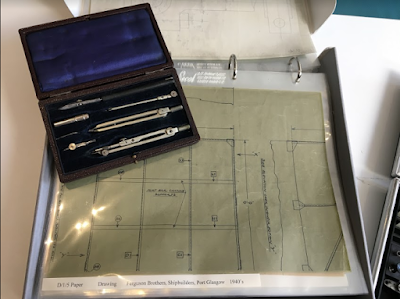Women working in Industry: Female Tracers.
1:55 PM
The crucial role of female workers within the shipping, manufacturing, and engineering industries has become more visible recently with campaigns and online content created by University of Glasgow Archives and Special Collections, Glasgow Women’s Library, Go Industrial, Inverclyde Shipbuilding and Engineering and Imperial War Museum alongside other institutions that seeks to understand, identify and raise awareness of the important role women played within Scotland’s Industrial history.
My initial inspiration to write a blog post focusing on 'Women at Work’ came after conversations with colleagues on females working in the shipyards and in engineering firms which led me to find out more about the role of female tracers. The image above is of the tracing department at Fairfield’s Shipbuilding and Engineering Company in Govan c.1909.
Female tracers worked in the drawing offices and traced over the drawings made by draftsmen to make the final original design. The need for tracers is often put down to the increased demand for engineers, however it was mainly down to the fact that women were able to trace over these plans with care and precision, it took great skill to be able to become a tracer.
To become a tracer, you would have to complete an apprenticeship in a tracing office. The length of these apprenticeships seems to vary between companies but range from nine months to five years. The tracing offices were made up of female employees who were very much kept separate from their male colleagues or draftsmen.
The above image shows the drawing office where draftsmen would have completed their plans before sending them though to the tracers. Despite men and women being kept separate both workrooms are similar in layout and there aesthetic. This image was also taken at Fairfield’s Shipbuilding and Engineering Company in Govan c.1909.
I was fortunate enough to be put in contact with Ann Wilson who had previously completed a nine-month apprenticeship with Loudon’s engineering shop in Paisley and had then gone on to work with the G.P.O (general post office) for 29 years as a tracer. In this blog I have recounted her time spent as an apprentice and then as a tracer to give more information on the job and what was involved.
Tracers worked solely with ink and linen cloth. Once the cloth had been stretched using four pins, chalk was rubbed into the warp and weft of the linen and left overnight. In the morning the plan drawn by the draughtsman would be slid under the cloth and then weighted. In shipbuilding, plans came in two different sizes; 32” and 46”. Tracers would sometimes work together to complete a drawing if necessary.
The use of linen, as Ann recalls, was a difficult material to work with. Using chalk before applying the ink would provide a surface texture making it easier to apply. The tools used were also the same tools used by draftsmen. If too much ink was placed into the pen it would run onto the linen and spoil the drawing. However, the time it took for the ink to dry would have been minutes as it was applied finely onto the linen. The boards used were tilted at an angle towards the tracer, an office could have up to twenty tracers working in the offices at one time. These boards could be adjusted and set flat depending on the need of the tracer. Set-squares, straight edges and curves were all crucial parts of the tracer’s toolkit, often straight lines were drawn first with corners added in afterwards.
We were also fortunate to find some tracers tools which had belonged to Duncan Winning. These would have been used by both draftsmen and tracers.
One of the most useful resources at The Trust is a folder compiled by Duncan for the National Records of Scotland which documents the different types of materials that would have been used for plans. This folder is an invaluable resource when cataloging large rolls of plans made up of different types of material, for example; plastic, cartridge, paper and linen. The image below shows a paper drawing from Ferguson Brothers Shipbuilders, Port Glasgow next to a set of tools that a tracer would have used to draw a similar plan.
Not every plan was simply a straightforward copy, at times tracers were required to add in adjustments or alterations, this included making one drawing from multiple plans; each dependant on what the individual order demanded. Many drawings required different levels of detail which the tracer would build upon until the full drawing was completed.
Thanks to Ann Wilson and Craig Osborne our volunteer for sharing their knowledge on the work of female tracers.
Links and References
- The Girls Own Paper, 1880-1907 ed. Terri Doughty. Broadview Press, March 2004.
- Go Industrial, Women at Work on the Clyde blog post.
- Go Industrial Collections.
- A Girl's Career, Glasgow Women's Library.
- WW1 - Women in Shipbuilding. Inverclyde Shipbuilding and Engineering.
- The Women's Work in the Transport Services, Imperial War Museum Collections.
- A Day in the Life of a Munitions Worker, Imperial War Museum.
- The Glasgow Story, Drilling at Linthouse Shipyard. Image from Glasgow University Archive Services.
- Women's History Scotland.
- Scottish Archives for Schools, The Role of Women in Industry.





1 comments
Do you know when the blueprint copying machines came into general use in the UK?
ReplyDelete